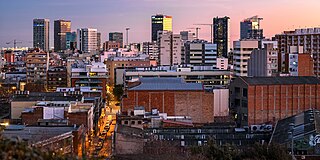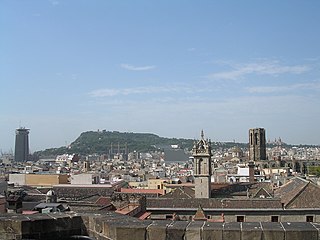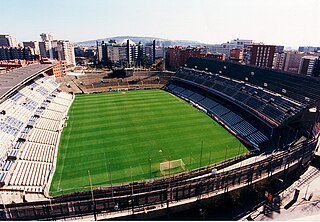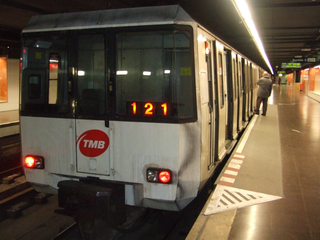
L'Hospitalet de Llobregat, often shortened to L'Hospitalet or just L'H, is a municipality in the Barcelonès comarca, in Catalonia (Spain). It is part of the Barcelona metropolitan area, the Barcelona province, and of the Barcelona conurbation.

Montjuïc is a hill in Barcelona, Catalonia, Spain.

Camp Nou, branded as Spotify Camp Nou for sponsorship reasons, is the home of La Liga club Barcelona since its completion in 1957. With a current seating capacity of 99,354, it is the stadium with the largest capacity in Spain and Europe, and the fifth largest football stadium in the world.

Estadi Olímpic Lluís Companys is a stadium in Barcelona, Catalonia, Spain. Originally built in 1927 for the 1929 International Exposition in the city, it was renovated in 1989 to be the main stadium for the 1992 Summer Olympics and 1992 Summer Paralympics. It is the home stadium of FC Barcelona for the 2023–24 season due to the renovation of their regular ground, Camp Nou.

Mestalla Stadium is a football stadium in Valencia, Spain. The stadium is the home of Valencia and has a capacity of 49,430 seats, making it the 8th-largest stadium in Spain, and the largest in the Valencian Community. The stadium's name originates from the historic irrigation canal of Mestalla, which was developed and consolidated during the Arab dynasty between the 10th and 11th centuries, and was originally outside the south stand of the stadium where it had to be jumped over in order to get to the ground. The North Stand of the stadium is known for its very steep section.

Sarrià Stadium was a football stadium in Barcelona, Catalonia, Spain. The stadium was the home of RCD Espanyol from 1923 to 1997, and was located in the district of Sarrià.

Line 1, shortened to L1, coloured red and often simply called Línia vermella, is the second oldest Barcelona Metro line, after line L3. It is the longest line of the Barcelona Metro, and links L'Hospitalet de Llobregat and Santa Coloma de Gramenet. Originally operated by the independent Ferrocarril Metropolitano Transversal de Barcelona, it is today operated by Transports Metropolitans de Barcelona (TMB) and is part of the ATM fare-integrated main transport system. L1 is the only metro line in Spain to use Iberian gauge tracks, as used by most Spanish main line railways.

Hospital de Bellvitge, formerly known as Feixa Llarga, is a Barcelona Metro station, in the L'Hospitalet de Llobregat municipality of the Barcelona metropolitan area, and named after the nearby Bellvitge University Hospital. The station is the western terminus of line L1.
El Gornal, or simply Gornal, is a neighbourhood in L'Hospitalet de Llobregat, belonging to the metropolitan area of Barcelona. It's part of District VI of L'Hospitalet, along with Bellvitge. Its creation started with the urban expansion of Bellvitge into empty terrains around Renfe railtracks. From the 1970s on it has been growing extensively, with the introduction of apartment blocks destined for low-income people.

Gornal is a railway station on the Llobregat–Anoia Line. It is located in the neighborhood of the same name, in the L'Hospitalet de Llobregat municipality, to the south-west of Barcelona, in Catalonia, Spain. It was opened in 1987, when the line's section between Ildefons Cerdà and Sant Josep stations was put underground. It is served by Barcelona Metro line 8, Baix Llobregat Metro lines S33, S4 and S8, and commuter rail lines R5, R6, R50 and R60.

Bellvitge | Rambla Marina is a Barcelona Metro station, in the L'Hospitalet de Llobregat municipality of the Barcelona metropolitan area, and named after the nearby neighbourhood of Bellvitge. The station is served by line L1. It is some 750 metres (2,460 ft) west of Bellvitge railway station, served by Rodalies de Catalunya commuter and regional rail services.

Avinguda Carrilet, also known as L'Hospitalet Avinguda Carrilet, is an interchange complex underneath Avinguda Carrilet in the L'Hospitalet de Llobregat municipality, to the south-west of Barcelona, in Catalonia, Spain. It consists of a railway station on the Llobregat–Anoia Line and a Barcelona Metro line 1 (L1) station. The Llobregat–Anoia Line station is served by Barcelona Metro line 8 (L8), Baix Llobregat Metro lines S33, S4 and S8, and commuter rail lines R5, R6, R50 and R60. The services on the Llobregat–Anoia Line are operated by Ferrocarrils de la Generalitat de Catalunya (FGC), whilst the L1 is operated by Transports Metropolitans de Barcelona (TMB).

Bellvitge is a mostly working-class neighborhood in L'Hospitalet de Llobregat, belonging to the metropolitan area of Barcelona. It is part of L'Hospitalet's District VI, along with Gornal.

Rail transport in Catalonia operates on three rail gauges and services are operated by a variety of public operators:
Barcelona, the capital of Catalonia, is the second largest city and metropolitan area in Spain and sixth-most populous urban area in the European Union. It has hosted many major international tournaments and has professional teams in different sports.
Bellvitge station may refer to:

Bellvitge is a Rodalies de Catalunya commuter rail station serving the neighborhood of the same name, in the L'Hospitalet de Llobregat municipality, to the south-west of Barcelona, in Catalonia, Spain. It is on the conventional Madrid–Barcelona railway, between El Prat de Llobregat and Barcelona Sants, and is served by all trains on Barcelona commuter rail service lines R2 and R2 Nord, as well as some R2 Sud trains. Some trains on regional line R15 also call at the station.
Feixa Llarga may refer to:

Santfeliuenc Fútbol Club is a Spanish football team based in Sant Feliu de Llobregat, Barcelona in the autonomous community of Catalonia. Founded in 1907, it plays in Tercera División – Group 5, holding home games at Nou Estadi Municipal de Les Grases.
Rugby Club L'Hospitalet is a Spanish rugby team based in L'Hospitalet de Llobregat (Barcelona). Founded in 1973 as Unió Esportiva Bellvitge, it changed its name to the current one in 1984. The club has won the Spanish women's rugby championship three times.

















